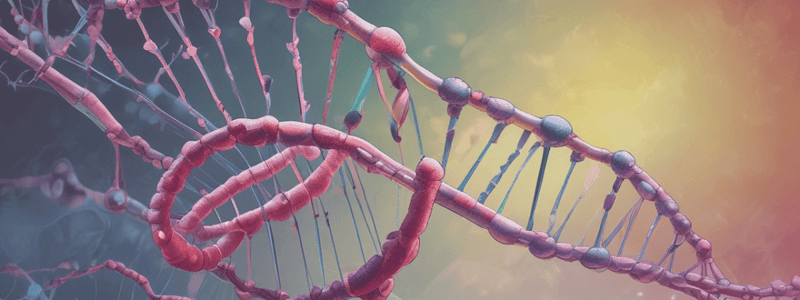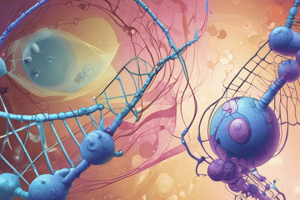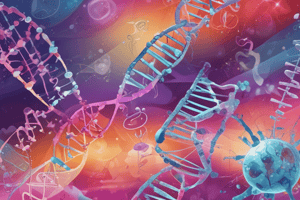Podcast
Questions and Answers
What is the main objective of studying DNA alkylating agents in the context of cancer chemotherapy?
What is the main objective of studying DNA alkylating agents in the context of cancer chemotherapy?
- To analyze the toxicity of platinum electrodes and ammonium chloride salt in solution
- To discuss the rational use of alkylating agents in the chemotherapy of cancer (correct)
- To comprehend the DNA alkylation/methylation/complexation of cisplatin, mitomycin C, and nitrogen mustards
- To understand the effects of electric current on E.coli cells
Which of the following drugs is a platinum-based chemotherapy agent?
Which of the following drugs is a platinum-based chemotherapy agent?
- Mitomycin C
- Cisplatin (correct)
- Triazenes
- Nitrogen mustards
What is the chemical name for Cisplatin?
What is the chemical name for Cisplatin?
- trans-diaminodichloroplatinum II
- cis-diaminodichloroplatinum II (correct)
- cis-diaminodichloroplatinum I
- trans-diaminodichloroplatinum I
What is the primary mechanism of action of cisplatin in inhibiting bacterial cell division?
What is the primary mechanism of action of cisplatin in inhibiting bacterial cell division?
Which of the following is not a DNA interactive drug mentioned in the lecture?
Which of the following is not a DNA interactive drug mentioned in the lecture?
Which of the following is the most effective but highly toxic chemotherapy agent mentioned in the lecture?
Which of the following is the most effective but highly toxic chemotherapy agent mentioned in the lecture?
What is a drawback of Dacarbazine based on the provided text?
What is a drawback of Dacarbazine based on the provided text?
Which statement about Temozolomide's mechanism of action is accurate based on the text?
Which statement about Temozolomide's mechanism of action is accurate based on the text?
What is a key advantage of Temozolomide over Dacarbazine in terms of bioactivation?
What is a key advantage of Temozolomide over Dacarbazine in terms of bioactivation?
Which feature contributes to the selectivity of Temozolomide towards malignant tissues?
Which feature contributes to the selectivity of Temozolomide towards malignant tissues?
What is a characteristic of Temozolomide's bioactivation process?
What is a characteristic of Temozolomide's bioactivation process?
Why is bone marrow suppression considered dose-limiting for Temozolomide?
Why is bone marrow suppression considered dose-limiting for Temozolomide?
What is the mechanism of action of cisplatin in the cytoplasm?
What is the mechanism of action of cisplatin in the cytoplasm?
What is the role of the Pt-DNA adduct in cell replication?
What is the role of the Pt-DNA adduct in cell replication?
What is the main cytotoxic mechanism of dacarbazine?
What is the main cytotoxic mechanism of dacarbazine?
Which of the following is a DNA mono alkylating agent?
Which of the following is a DNA mono alkylating agent?
What is the role of 5-aminoimidazole-4-carboxamide in the mechanism of action of dacarbazine?
What is the role of 5-aminoimidazole-4-carboxamide in the mechanism of action of dacarbazine?
What is the major methylation site of dacarbazine in DNA?
What is the major methylation site of dacarbazine in DNA?
What is the role of zinc-finger protein transcription factor in the mechanism of action of cisplatin?
What is the role of zinc-finger protein transcription factor in the mechanism of action of cisplatin?
What is the mechanism of action of carboplatin?
What is the mechanism of action of carboplatin?
What is the main side effect of cisplatin?
What is the main side effect of cisplatin?
What is the role of CYP-450 in the mechanism of action of dacarbazine?
What is the role of CYP-450 in the mechanism of action of dacarbazine?
Study Notes
DNA Alkylating Agents
- DNA alkylating agents are used in chemotherapy to treat cancer.
- These agents interact with DNA and alter its structure, leading to cytotoxicity.
Platinum Drugs - Cisplatin
- Cisplatin (cis-diamminedichloroplatinum II) was discovered in the study of the effects of electric current on cells.
- It was found to be very effective but also highly toxic.
- Cisplatin is a square planar complex containing two labile chlorines and two inert ammonia molecules.
- The high chloride concentration in plasma prevents hydrolysis of the chloride bonds, but in the cytoplasm, the lower chloride concentration allows the reaction with water to give the positively charged hydrated species.
- The active complex then enters the cell nucleus and becomes attracted electrostatically to the negatively charged DNA.
- The electrostatic interaction is followed by displacement of the two water molecules by guanine N-7, leading to interstrand crosslinking and formation of a Pt-DNA adduct.
- Pt-DNA adduct formation leads to deformation of the DNA tertiary structure, causing unwinding at the Pt-DNA adduct site, and prevention of DNA replication.
- Additionally, Pt replaces Zn in the zinc-finger protein transcription factor, disrupting the conformation and binding the zinc-finger permanently to DNA-polymerase alpha, which is a transcription enzyme vital for cell replication.
Temozolomide
- Temozolomide (Temodal) is a prodrug that is bioactivated through a non-enzymatic hydrolysis reaction followed by spontaneous decarboxylation.
- The absence of hepatic activation is an advantage, as it eliminates the need to consider individual variations in patient microsomal enzyme activity.
- Temozolomide accumulates within tumors, where it methylates the O6 and N7 positions of guanine.
- Methylation is also favored in guanine-rich regions.
- Temozolomide activity also depends partly on the less abundant O6-MeG adducts and on the operation of the mismatch repair enzymes (MMRs) which detect the O6-MeG-T mispairing.
- The MMRs excise the erroneous T and replace it with another T, leading to a frenzy of activity that triggers cell death.
- Selectivity is due to differences in the pH environment of normal vs. malignant tissue in the brain.
- Temozolomide is used to treat brain tumors and has good oral bioavailability and distribution properties.
Dacarbazine
- Dacarbazine is a DNA monoalkylating agent.
- It is used to treat malignant melanoma, Hodgkin's disease, and glioblastoma (brain tumor).
- Dacarbazine has a wide spectrum of activity, ranging from malignant lymphomas to melanomas and sarcomas.
- Originally designed as an antimetabolite, it was established that its mechanism of action was not associated with inhibition of purine synthesis.
- Rather, cytotoxicity is due to the generation of the methyldiazonium ion, which methylates DNA at N7 positions of guanine.
- The methyldiazonium ion is a DNA methylating species that is responsible for the cytotoxicity of dacarbazine.
- Dacarbazine is used as a mono-therapy to treat metastatic melanoma and in combination with other drugs to treat Hodgkin's disease.
The Triazenes
- The triazenes are DNA monoalkylating agents.
- They include dacarbazine and temozolomide.
- These agents are employed in combination therapy to treat malignant melanoma and Hodgkin's disease.
- The triazenes are used to treat glioblastoma (brain tumor).
Studying That Suits You
Use AI to generate personalized quizzes and flashcards to suit your learning preferences.
Description
Learn about DNA alkylating agents and their use in cancer chemotherapy. Explore the mechanisms of action of cisplatin, mitomycin C, triazenes, and nitrogen mustards in DNA alkylation, methylation, and complexation.




